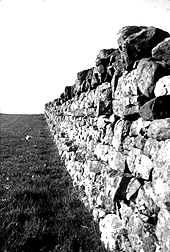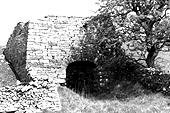| Sheepfolds to Visit | |
News | Education | Images | Accessibility | Search | Links |
 |
In choosing dry stone walling as a medium for his work, Andy Goldsworthy pays homage to the knowledge and skills of farmers and wallers. He uses professional wallers who still practice their craft - men like the World Champion waller, Steve Allen - to build or rebuild folds on the sites he has selected. Their methods and techniques reveal interesting examples of simple structures and basic principles of construction for study in DESIGN & TECHNOLOGY. The dry stone walls of the Sheepfolds are made by building two parallel walls side by side, wider at the base and slightly tapering together near the top. (Children might consider how much firmer we stand when we spread our legs rather than keep our feet together.) Each course of stonework is carefully tessellated so that the joints between the courses are staggered and do not create weaknesses or cracks running up or across the walls. Large stones or boulders are generally used at the base of the walls to carry the weight and act as a foundation. Rubble is used to fill the cavity in the centre and periodically larger or longer stones are used to run across this cavity and tie the two walls together. These are known as 'through stones' and often project out from the face of the wall. Stones are then placed on the top of the finished wall to cap it and prevent water penetrating the centre. These capping stones are sometimes lent in the direction of the prevailing weather to shed the rain more effectively. (4) When Andy Goldsworthy builds a cone himself he uses similar techniques. He starts the work on a large flat base or foundation stone to spread the weight of the cone and prevent it from settling or moving. From this he builds up courses of stone gradually increasing the circumference layer by layer. Each new course jetties out a little further, like reversed corbelling, until the shape of the cone reaches its widest point. Every course has at least one 'through stone' which runs across the diameter from one side to the other. These 'throughs' are laid in opposite or a different direction from that in the previous or lower layer. From the fattest part of the cone, he then brings the circumference of each course in slightly until the shape reaches its full height. Andy Goldsworthy's 'Drove Arch', that he built and re-built in derelict folds on a drove route from Scotland through Cumbria, also alerts us to the structural features of arches and vaulting used in the vernacular architecture of Cumbria. The weight of the arch is perfectly distributed down through the semi-circle of wedge shaped stones and locks the 'key stone' into place in the centre. Such a delicately balanced springing structure can, almost magically, carry an enormous load, as can be seen in the barns, bridges and lime kilns around us. Photographs
|
|
|
© 2002 Copyright
Information
|
.

